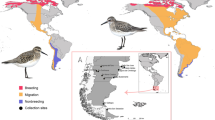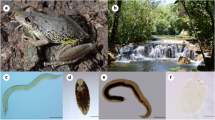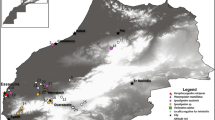Summary
The helminth communities from ten species of lizard on seven islands in the Caribbean were sampled by collecting one hundred specimens of each species. Nine genera of parasites were identified; these included six nematodes, two digeneans and an acanthocephalan. No relationship was discernible between parasite density or abundance and island area or altitude, although dry islands tend to have fewer species of parasites. Anolis lizards of the bimaculatus and wattsi series share similar parasites with four out of nine species common to both series. The parasite community of lizards on these islands is depauperate with respect to similar surveys on the larger islands of the Greater Antilles.
On three of the islands lizards were sub-sampled by collecting from moist woodland and more xeric habitats. These data suggest that differences between habitats are as significant as differences between islands in determining parasite burdens. Worm burdens of the commonest parasite species, T. cubensis, increased monotonically with host body size and no evidence was found to suggest that these parasites affect either host survival or fecundity. The sex-ratio of this species correlated with mean abundance of the parasite, with females the dominant sex on islands or in habitats where the parasite was common. This pattern may reflect haplodiploid sexual determination in this species.
Similar content being viewed by others
References
Acholonu AD (1970) Studies on Mesocoelium danforthi Hoffmann, 1935 (Trematoda: Brachycoeliidae) and its distribution in the herpetofauna of the Greater Antilles. J Parasit 56: [Suppl] 703:391
Adamson ML (1984) Haplodiploidy in Aspicularis tetraptera (Nitzch) (Heteroxynematidae) and Syphacia obvelata (Rudolphi) (Oxyuridae), nematode (Oxyurida) parasite of Mus musculus. Can J Zool 62:804–807
Adamson ML, Petter AJ (1983) Studies on gametogenesis in Tachygonetria vivipara Wedl, 1862 and Thelandros alatus, Wedl, 1862 (Oxyuroidea: Nematoda) from Uromastix acanthinuris in Morroco. Can J Zool 61:2357–2360
Anderson RM (1978) The regulation of host parasite growth by parasite species. Parasitology 76:119–157
Anderson RM, Gordon DM (1982) Processes influencing the distribution of parasite numbers within host populations with special emphasis on parasite-induced host mortalities. Parasitology 85:373–398
Barus V, Coy Otero A (1969) Systematic survey of nematodes parasitizing lizards (Sauria) in Cuba. Helminthologica 10:329–346
Barus V, Coy Otero A (1973) Nematodes of the genera Spaulingodon, Skrjabinodon and Pharyngodon (Oxyuridae) parasitizing Cuban lizards. Vestnik Ceskoslovenske Spolecnosti Zoologicke 38:1–12
Bundy DAB, Vogel P, Harris EA (1987) Helminth parasites of Jamaican anoles (Reptilia: Iguanidae): a comparison of the helminth fauna of six Anolis species. J Helminthol 61:77–83
Chitwood BG (1934) Reports on the collections obtained by the first Johnston-Smithsonian deep-sea expedition to the Puerto-Rican Deep. Two new nematodes. Smith Inst Miscell Coll 91:1–4
Cofresi-Sala F (1964) Notes on distribution and a redescription of Mesocoelium danforthi. Carib J Science 4:435–439
Coy Otero A, Barus V (1973) Notes on nematodes of the genus Cyrtosomum (Atractidae) parasitic in Cuban lizards (Sauria). Folia Parasitologica (Praha) 20:297–305
Dobson AP (1988) Restoring island ecosystems: The potential of parasites to control introduced mammals. Conserv Biology 2:31–39
Dobson AP, Pacala SW (1992) The parasites of Anolis lizards in the northern Lesser Antilles. II. The structure of the parasite community. Oecologia 92:118–125
Gorman GC, Buth DG, Wyles JS (1980) Anolis lizards of the Eastern Caribbean: a case study of evolution. III. A cladistic analysis of albumin immunological data, and the definition of species groups. System Zool 29:143–158
Kennedy CR (1978) The parasite fauna of resident char Salvelinus alpinus from Arctic islands, with special reference to Bear Island. J Fish Biol 13:255–263
Kennedy CR, Laffoley Dd'A, Bishop G, Jones P, Taylor M (1986) Communities of parasites of freshwater fish of Jersey, Channel Islands. J Fish Biol 29:215–226
Lazell JD (1972) The anoles (Sauria, Iguanidae) of the Lesser Antilles. Bull Mus Comp Zool 143:1–115
Lewis JW (1968a) Studies on the helminth parasites of the Longtailed field mouse, Apodemus sylvaticus sylvaticus from Wales. J Zool Lond 54:287–312
Lewis JW (1968b) Studies on helminth parasites of voles and shrews from Wales. J Zool Lond 154:313–331
McLaughlin JF, Roughgarden J (1989) Avian predation on Anolis lizards in the Northeastern Caribbean: an inter-island contrast. Ecology 70:617–628
Pacala SW, Roughgarden J (1985) Population experiments with the Anolis lizards of St. Maarten and St. Eustatius. Ecology 66:129–141
Pacala SW, Dobson AP (1988) The relation between the number of parasites per host and host age: population dynamic causes and maximum-likelihood estimation. Parasitology 96:197–210
Prudhoe S, Bray RA (1982) Platyhelminth parasites of the Amphibia. British Museum (Natural History). Oxford University Press
Roche M, Patrzek D (1966) The female to male ratio (FMR) in hookworm. J Parasit 52 117–121
Roughgarden JH (1992) Anolis Lizards of the Caribbean: Ecology, Evolution and Plate Tectonics. Oxford University Press:
Roughgarden JD, Gaines SD, Pacala SW (1987) Supply side ecology: the role of physical transport processes. In Giller P, Gee J (eds) Organization of Communities: Past and Present. Proceedings of the British Ecological Society Symposium, Aberystwyth. Blackwell Scientific Publications, London
Roughgarden JD, Heckel D, Fuentes ER (1983) Coevolutionary theory and the biogeography and community structure of Anolis. In: Huey RB, Pianka ER, Schoener TW (eds) Lizard Ecology, Studies of a Model Organism. Harvard University Press, Cambridge, MA pp 371–410
Roughgarden JD, Pacala SW, Rummel JD (1984) Strong presentday competition between the Anolis lizard populations of StMaarten (Neth. Antilles). In: Shorrocks B (ed). Evolutionary Ecology Blackwell Scientific Publications, Oxford: pp 203–220
Rummell JD. Roughgarden JD (1985) Effects of reduced perchheight seperation on competition between two Anolis lizards. Ecology 66:430–444
Singhvi A, Johnson S (1977) The female to male ratio (FMR) in dominant nematode populations in the house rat, Rattus rattus. J Parasitol 63:858–860
Sokal RR, Rohlf LJ (1969) Biometry. W.H. Freeman, San Francisco, California
Stoffers AL (1956) The vegetation of the Netherlands Antilles. Studies of the Flora of Curacao and other Caribbean islands. 1:1–142
Vogel P, Bundy DAB (1987) Helminth parasites of Jamaican Anoles (Reptilia: Iguanidae): Variation in prevalence and intensity with host age and sex in a population of Anolis lineatopus. Parasitology 94:399–404
Williams EE (1983) Ecomorphs, faunas, island size, and diverse end points in island radiations of Anolis. In: Huey RB, Pianka ER, Schoener TW (eds) Lizard Ecology, Studies of a Model Organism. Harvard University Press, Cambridge, MA: pp. 326–370
Author information
Authors and Affiliations
Rights and permissions
About this article
Cite this article
Dobson, A.P., Pacala, S.V., Roughgarden, J.D. et al. The parasites of Anolis lizards in the northern Lesser Antilles. Oecologia 91, 110–117 (1992). https://doi.org/10.1007/BF00317248
Received:
Accepted:
Issue Date:
DOI: https://doi.org/10.1007/BF00317248




